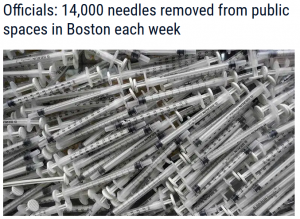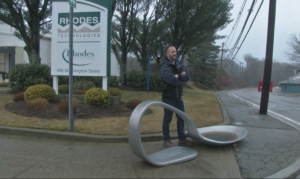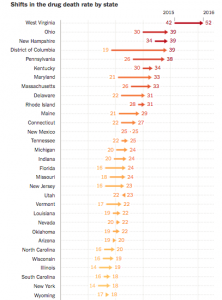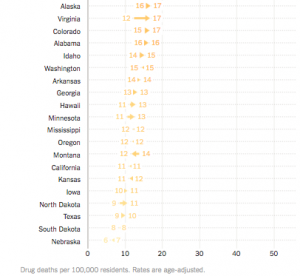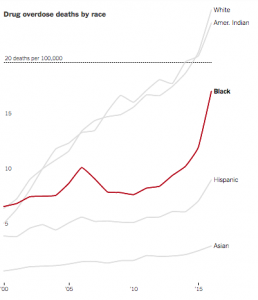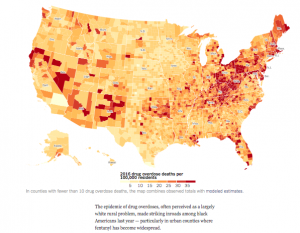Navigation
Install the app
How to install the app on iOS
Follow along with the video below to see how to install our site as a web app on your home screen.

Note: this_feature_currently_requires_accessing_site_using_safari
More options
You are using an out of date browser. It may not display this or other websites correctly.
You should upgrade or use an alternative browser.
You should upgrade or use an alternative browser.
Opioid Epidemic 'Getting Worse Instead of Better,' Public Health Officials Warn
- Thread in 'General' Thread starter Started by hand2handking,
- Start date
- 35,400
- 77,874
- Joined
- Dec 27, 2014
All business in the front. Party in the back.
- 6,847
- 16,664
- Joined
- Jun 28, 2004
In is funny how the official narrative for every white, middle class suburban addiction case is based on an honor student or otherwise solid citizen who sprains an ankle while doing a charity run, they get prescribed a few vicodins and within a year, they are addicted to heroin and OD and die. The dirty little secret is that white suburbanites loe drugs and they were taking drugs before, during and after the era of easy oxycontin which was circa 1998 to 2008. blaming big pharma (which is scummy in a variety of ways, mostly when it comes to their pricing policies for life saving drugs) is hilariously ironic for a community that has demanded that everyone else practice "personal responsibility" and never blame outside forces for their problems.
- 35,400
- 77,874
- Joined
- Dec 27, 2014
Soaring overdose deaths cut US life expectancy for 2nd year
https://www.boston.com/news/nationa...-2nd-year?s_campaign=bcom:socialflow:facebook
NEW YORK (AP) — U.S. deaths from drug overdoses skyrocketed 21 percent last year, and for the second straight year dragged down how long Americans are expected to live.
The government figures released Thursday put drug deaths at 63,600, up from about 52,000 in 2015. For the first time, the powerful painkiller fentanyl and its close opioid cousins played a bigger role in the deaths than any other legal or illegal drug, surpassing prescription pain pills and heroin.
“This is urgent and deadly,” said Dr. Brenda Fitzgerald, director of the Centers for Disease Control and Prevention. The opioid epidemic “clearly has a huge impact on our entire society.”
Two-thirds of last year’s drug deaths — about 42,000 — involved opioids, a category that includes heroin, methadone, prescription pain pills like OxyContin, and fentanyl. Fatal overdoses that involved fentanyl and fentanyl-like drugs doubled in one year, to more than 19,000, mostly from illegally made pills or powder, which is often mixed with heroin or other drugs.
Heroin was tied to 15,500 deaths and prescription painkillers to 14,500 deaths. The balance of the overdose deaths involved sedatives, cocaine and methamphetamines. More than one drug is often involved in an overdose death.
The highest drug death rates were in ages 25 to 54.
Preliminary 2017 figures show the rise in overdose deaths continuing.
The drug deaths weigh into CDC’s annual calculation of the average time a person is expected to live. The life expectancy figure is based on the year of their birth, current death trends and other factors. For decades, it was on the upswing, rising a few months nearly every year. But last year marked the first time in more than a half century that U.S. life expectancy fell two consecutive years.
A baby born last year in the U.S. is expected to live about 78 years and 7 months, on average, the CDC said. An American born in 2015 was expected to live about a month longer and one born in 2014 about two months longer than that.
https://www.boston.com/news/nationa...-2nd-year?s_campaign=bcom:socialflow:facebook
NEW YORK (AP) — U.S. deaths from drug overdoses skyrocketed 21 percent last year, and for the second straight year dragged down how long Americans are expected to live.
The government figures released Thursday put drug deaths at 63,600, up from about 52,000 in 2015. For the first time, the powerful painkiller fentanyl and its close opioid cousins played a bigger role in the deaths than any other legal or illegal drug, surpassing prescription pain pills and heroin.
“This is urgent and deadly,” said Dr. Brenda Fitzgerald, director of the Centers for Disease Control and Prevention. The opioid epidemic “clearly has a huge impact on our entire society.”
Two-thirds of last year’s drug deaths — about 42,000 — involved opioids, a category that includes heroin, methadone, prescription pain pills like OxyContin, and fentanyl. Fatal overdoses that involved fentanyl and fentanyl-like drugs doubled in one year, to more than 19,000, mostly from illegally made pills or powder, which is often mixed with heroin or other drugs.
Heroin was tied to 15,500 deaths and prescription painkillers to 14,500 deaths. The balance of the overdose deaths involved sedatives, cocaine and methamphetamines. More than one drug is often involved in an overdose death.
The highest drug death rates were in ages 25 to 54.
Preliminary 2017 figures show the rise in overdose deaths continuing.
The drug deaths weigh into CDC’s annual calculation of the average time a person is expected to live. The life expectancy figure is based on the year of their birth, current death trends and other factors. For decades, it was on the upswing, rising a few months nearly every year. But last year marked the first time in more than a half century that U.S. life expectancy fell two consecutive years.
A baby born last year in the U.S. is expected to live about 78 years and 7 months, on average, the CDC said. An American born in 2015 was expected to live about a month longer and one born in 2014 about two months longer than that.
- 18,115
- 11,770
- Joined
- Jan 11, 2013
Doctor Faces Charges Over Opioid Prescriptions and 5 Patient Deaths

Dr. Raymond Kraynak, here in 2014, faces charges related to the deaths of five patients.
http://www.cnn.com/2017/12/22/health/doctor-opioid-prescription/index.html

Dr. Raymond Kraynak, here in 2014, faces charges related to the deaths of five patients.
http://www.cnn.com/2017/12/22/health/doctor-opioid-prescription/index.html
(CNN) A Pennsylvania doctor charged with causing the deaths of five patients by unlawfully prescribing opioids surrendered his license to prescribe controlled substances at a federal court hearing Friday, officials said.
Dr. Raymond Kraynak -- whom prosecutors say prescribed nearly 3 million doses of opioids from January 2016 to July -- also was released from custody Friday after posting a $500,000 bond, the US attorney's office for the Middle District of Pennsylvania said.
Kraynak now awaits trial at a date yet to be determined.
Kraynak, 60, of Mount Carmel, Pennsylvania, was arrested Thursday. He is accused of, among other things, causing five deaths of patients between 2013 and 2015 by "unlawfully distributing and dispensing controlled substances" to them, according to the US Justice Department.
Prosecutors also allege that Kraynak, between 2005 and 2016, prescribed opioids "without a legitimate medical purpose' and "without conducting a proper medical examination," the US attorney's office said.
He is accused of failing to verify patients' medical complaints adequately and patients' risk of abuse before prescribing the drugs, the prosecution said.
Kraynak, who had offices in the central Pennsylvania communities of Mount Carmel and Shamokin, will plead not guilty, public defender Thomas Thornton said. Kraynak treats people in a small part of Pennsylvania where they don't have doctors, Thornton said.
"At this point we really haven't had a chance to see the evidence against him," his attorney said. "We're more concerned about his patients right now."
The US attorney's office alleges that Kraynak was the top prescriber in the state for opioids, writing ones for about 2.7 million doses of oxycodone, hydrocodone, oxycontin and fentanyl within 19 months. Those prescriptions were written for about 2,838 patients.
"The sheer number of pills prescribed in this case is staggering," US Attorney David Freed said in a statement. "Death or serious injury was the inevitable result of this defendant's conduct."
Kraynak is facing 19 charges, including five counts of the unlawful distribution and dispensing of a controlled substance resulting in death, 12 counts of prescribing controlled substances outside the usual course of professional practice and two counts of maintaining drug-involved premises at his offices.
It's not unprecedented for a doctor to be charged with causing the death of a patient through prescriptions. There have been similar cases in the past several years where doctors were held accountable in the deaths of patients who overdosed on opioid painkillers that had been prescribed.
In 2015, a doctor in Southern California was convicted of second-degree murder for the overdose deaths of three patients. She was sentenced to 30 years to life in prison.
In the Kraynak case, the government seeks the forfeiture of two medical offices, his medical license and $500,000, according to a DOJ statement announcing the indictment.
If convicted, Kraynak faces a mandatory 20 years to life in prison for each of the counts involving the five patients. The other 14 charges are each punishable by up to 20 years in prison.
The charges were the result of an investigation by the Drug Enforcement Administration with assistance from state and local police.
Kraynak has a license in osteopathic medicine and had come to attention of the state board for his prescription practices. In 2012, he agreed to complete a medical course after prescribing large amounts of "various controlled substances" to seven patients from January 2007 through June 2008. The record does not identify what he had prescribed. The State Board of Osteopathic Medicine fined Kraynak $2,500.
The United States is in the throes of an opioid epidemic as more Americans have become dependent or abuse prescription pain pills and street drugs. More than 63,600 lives were lost to drug overdose in 2016, marking the most lethal year yet of the drug overdose epidemic, according to a report released this week.
Last edited:
- 35,332
- 26,982
- Joined
- Jul 13, 2005
Couple of months before i take my pharmacy board exam, but as a future pharmacist we're definitely tryna decrease the amount of opioids prescribed. Lots of hospitals are using IV tylenol now instead of opioids which surprisingly provides similar pain relief.
As far as the community goes, that's where the real problem lies. In my area in NYC about 10 people died from that drug that's 10x more potent than fentanyl a couple months back. It's all accidental too. Too bad naloxone is so damn expensive that most drug users refuse to buy it even though it'll save a life.
As far as the community goes, that's where the real problem lies. In my area in NYC about 10 people died from that drug that's 10x more potent than fentanyl a couple months back. It's all accidental too. Too bad naloxone is so damn expensive that most drug users refuse to buy it even though it'll save a life.
- 15,448
- 16,778
- Joined
- Nov 2, 2006
A depressed ppl will resort to anything for anything to pick them up.
- 30,252
- 40,601
- Joined
- May 25, 2004
Saw some lady passed out on my neighbors steps the other day. It’s and every day occurrence.
Government is gonna destroy us all. I don’t know why we can’t pull the same move Iceland did. Americans are too brain washed and ***** made for that.
Government is gonna destroy us all. I don’t know why we can’t pull the same move Iceland did. Americans are too brain washed and ***** made for that.
- 23,002
- 27,719
- Joined
- Aug 14, 2012
Saw some lady passed out on my neighbors steps the other day. It’s and every day occurrence.
Government is gonna destroy us all. I don’t know why we can’t pull the same move Iceland did. Americans are too brain washed and ***** made for that.
What did Iceland do?
- 30,252
- 40,601
- Joined
- May 25, 2004
What did Iceland do?
Overthrew their government and threw all the corrupt politicians and police in jail.
- 18,115
- 11,770
- Joined
- Jan 11, 2013
The Opioid Crisis Is Getting Worse, Particularly for Black Americans

https://www.nytimes.com/interactive...column-region®ion=top-news&WT.nav=top-news

https://www.nytimes.com/interactive...column-region®ion=top-news&WT.nav=top-news
The epidemic of drug overdoses, often perceived as a largely white rural problem, made striking inroads among black Americans last year — particularly in urban counties where fentanyl has become widespread.
Although the steep rise in 2016 drug deaths has been noted previously, these are the first numbers from the Centers for Disease Control and Prevention to break down 2016 mortality along geographic and racial lines. They reveal that the drug death rate is rising most steeply among blacks, with those between the ages of 45 and 64 among the hardest hit.

Drug deaths among blacks in urban counties rose by 41 percent in 2016, far outpacing any other racial or ethnic group. In those same counties, the drug death rate among whites rose by 19 percent. The data, released on Thursday, suggests that the common perception of the epidemic as an almost entirely white problem rooted in overprescription of painkillers is no longer accurate, as fentanyl, often stealthily, invades broader swaths of the country and its population.

Driven by the continued surge in drug deaths, life expectancy in the United States dropped for the second year in a row last year. It’s the first consecutive decline in national life expectancy since 1963. Drug overdoses have now surpassed heart disease as the leading cause of death for Americans under the age of 55.
In Washington, D.C., the emergence of fentanyls caused the rate of drug deaths to double in a single year. The rate of drug deaths there is now on par with those in Ohio and New Hampshire. It’s an unsurprising consequence of an epidemic that is both widespread and extremely localized. If fentanyls enter the drug supply in one area, deaths can accumulate rapidly. Drug deaths are also up sharply in cities like St. Louis, Baltimore, Philadelphia and Jacksonville, Fla.
Dr. Andrew Kolodny, the co-director of opioid policy research at Brandeis University’s Heller School for Social Policy and Management, said it appeared that many of the African-Americans who died were older men who had become addicted to heroin during a previous epidemic in the 1970s. “Despite beating the odds for the past 40 to 50 years,” he said, “they’re dying because the heroin supply has never been so dangerous — increasingly it’s got fentanyl in it or it’s just fentanyl sold as heroin.”


Fentanyl-laced cocaine, too, may be playing a role. A study published this month in the journal Annals of Internal Medicine found that cocaine-related overdose deaths were nearly as common among black men between 2012 and 2015 as deaths due to prescription opioids in white men over the same period. Cocaine-related deaths were slightly more common in black women during that period than deaths due to heroin among white women, according to the study. But it also found that the largest recent increases in overdose deaths among blacks were attributed to heroin. One of the researchers, David Thomas of the National Institute on Drug Abuse, said he did not know whether some of the cocaine-attributed deaths in the study involved fentanyl, although he had heard anecdotally of such mixing.
The study, by researchers at the National Cancer Institute and the National Institute on Drug Abuse, also found that the recent rise in overdose death rates was sharpest among older blacks. The same held true last year in New York City.
“What’s really interesting is you’re not seeing younger blacks getting involved in heroin as much,” said Denise Paone, senior director of research and surveillance in the city’s Bureau of Alcohol and Drug Use Prevention.
Across the board, though, fentanyl has caused a huge spike in overdose deaths in New York in just the last year. Fentanyl played a role in about 16 percent of overdose deaths in 2015 and 44 percent in 2016, Dr. Paone said, compared with 3 percent in prior years. A growing number of the deaths involve cocaine cut with fentanyl, she added — which is probably particularly deadly for someone who has not used opioids before.
In Ohio, which had the nation’s second-highest overdose rate last year, the medical examiner in Cuyahoga County told a United States Senate subcommittee in May that a fast-rising rate of fentanyl-related deaths among blacks was probably a result of drug dealers mixing fentanyl with cocaine. In Cuyahoga County (the home of Cleveland), fentanyl contributed to the deaths of five African-Americans in 2014, 25 in 2015 and 58 in 2016. But both opioids and cocaine still kill far more whites than blacks there.
Brandon Marshall, an associate professor of epidemiology at the Brown University School of Public Health, said it was hard to sort out how many deaths involved people taking cocaine cut with fentanyl versus people who died of an opioid overdose but also happened to have cocaine in their blood at the time.
Dr. Kolodny said he believes the latter is more common. “Many people who are overdosing because of an extremely dangerous heroin supply also use other drugs,” he said, “so I think the cocaine is sort of an incidental finding.”
Health experts say the evolving nature of the crisis suggests that progress against it will be slow, despite stepped-up efforts to address it with medication-assisted treatment and naloxone, which can save people who have overdosed. As overdose deaths keep climbing, there is a good chance that life expectancy will be found to have declined again this year, said Robert Anderson, chief of the mortality statistics branch of the National Center for Health Statistics. If so, it would be the first three-year period of consecutive life expectancy declines since World War I and the Spanish flu pandemic in 1918.
Dr. Kolodny pointed to the rising drug death rate among older black men, many of whom he said have probably used heroin on and off since the 1970s, as evidence that progress against the new epidemic could take decades.
“Forty, 50 years later we’re still paying a price,” he said. “What this means is for our current epidemic, we’re going to be paying a very heavy human and economic price for the rest of our lives.”
I don't know how I feel about this. Seems like they are trying to push this **** into our community now. Look at the Rap videos in the mainstream promotion this and ****. I think this isn't big in our community yet, but could become a problem. I don't trust ******** in power.
- 18,115
- 11,770
- Joined
- Jan 11, 2013
https://www.usatoday.com/story/news...ns-drug-oxycodone-license-80-million/2412451/
A handful of members of Congress, allied with the nation’s major drug distributors, prevailed upon the DEA and the Justice Department to agree to a more industry-friendly law, undermining efforts to stanch the flow of pain pills, according to an investigation by The Washington Post and “60 Minutes.” The DEA had opposed the effort for years.
The law was the crowning achievement of a multifaceted campaign by the drug industry to weaken aggressive DEA enforcement efforts against drug distribution companies that were supplying corrupt doctors and pharmacists who peddled narcotics to the black market. The industry worked behind the scenes with lobbyists and key members of Congress, pouring more than a million dollars into their election campaigns.
The chief advocate of the law that hobbled the DEA was Rep. Tom Marino,a Pennsylvania Republican who is now President Trump’s nominee to become the nation’s next drug czar.
- 10,215
- 3,311
- Joined
- Dec 9, 2001
This is why i always opt for the strongest ibuprofen instead of ANY Opioid. Working in healthcare for the last 6 years, ive heard about hundreds of cases of Opioid addiction. I dealt directly with cases for military members who needed Suboxone and couldnt get it approved for one reason or another. We even had a supervisor in the department having employees enter PA`s for her so she could get extra fills for herself. (all of which were fired.........but they were only doing what she asked them to do, SMH)
- 18,115
- 11,770
- Joined
- Jan 11, 2013
- 18,115
- 11,770
- Joined
- Jan 11, 2013
22 Stocks To Watch After President Trump Declares Opioid Epidemic A National Health Emergency

https://www.benzinga.com/news/17/10...trump-declares-opioid-epidemic-a-national-hea

https://www.benzinga.com/news/17/10...trump-declares-opioid-epidemic-a-national-hea
President Donald Trump catalyzed a selloff in opioid-exposed stocks Thursday as he declared the national epidemic a public health emergency and renewed the government’s crackdown on fentanyl.
“I will be pushing the concept of non addictive painkillers very, very hard,” Trump said. “We’re going to be spending lots of money on coming up with a non-addictive solutions.”
His announced intent to increase regulations around prescription strength and frequency bears implications on the following drug pharmaceuticals and distributors:
the following pharmacies:
- Insys Therapeutics Inc INSY 1.29%
- Pain Therapeutics, Inc. PTIE 0.96%
- BioDelivery Sciences International, Inc. BDSI 2.22%
- Collegium Pharmaceuticals Inc COLL 3.67%
- Zogenix, Inc. ZGNX 0.94%
- Zynerba Pharmaceuticals Inc ZYNE 0.71%
- Teva Pharmaceutical Industries Ltd (ADR) TEVA 0.16%
- Egalet Corp EGLT 0.26%
- Trevena Inc TRVN 7.95%
- GW Pharmaceuticals PLC - ADR GWPH 0.66%
- Pacira Pharmaceuticals Inc PCRX 4.47%
- Cara Therapeutics Inc CARA 0.82%
- Titan Pharmaceuticals, Inc. TTNP 9.09%
- AmerisourceBergen Corp. ABC 2.58%
- McKesson Corporation MCK 0.87%
- Cardinal Health Inc CAH 0.14%
the pharmacy benefits manager Express Scripts Holding Company ESRX 2.24%, and the substance abuse treatment center AAC Holdings Inc AAC 0.5%.
Opiant Pharmaceuticals Inc OPNT 6.1%, a developer of pharmacological treatments for substance use, addictive and eating disorders, was trading up 30 percent Thursday.
His strategy involves collaboration with the National Institutes of Health on marketing campaigns; use of Public Health Emergency funds; expansion of treatment opportunities; and cooperation with foreign governments, specifically China, to staunch the flow of drugs from international manufacturers.
“We have to work with other countries to stop these drugs where they originate,” he said. “We have no choice, we have to work together.”
Trump promoted participation in Saturday’s National Prescription Drug Takeback Day.
- 18,115
- 11,770
- Joined
- Jan 11, 2013
Jeff Sessions to Pain Sufferers: Take Two Aspirin and Stop Whining

Attorney General Jeff Sessions testifies before the Senate Judiciary Committee on Capitol Hill in Washington, Wednesday, Oct. 18, 2017. (AP Photo/Carolyn Kaster)
https://pjmedia.com/trending/jeff-sessions-pain-sufferers-take-two-aspirin-stop-whining/
Eight years ago this week, I was legally crossing a street in Washington, D.C. when I was struck down by a State Department security SUV making an illegal turn. My left tibial plateau was shattered, and I needed two major surgeries and many months of painful physical therapy to recover. All told, it was almost two years before I was able to walk unaided again without braces or crutches or canes, and I still don't have full movement in my left knee. It still aches most of the time, but I've learned to live with it.
I would not have been able to get through that long, painful ordeal without opioids. I don't think I'd be here right now if the only thing I'd been given to relieve the constant, tormenting pain was... aspirin.
Dan Sullivan, Tampa Bay Times:
U.S. Attorney General Jeff Sessions has drawn jeers for suggesting that people in pain should consider over-the-counter Bufferin instead of opioids...
"I am operating on the assumption that this country prescribes too many opioids," Sessions said. "People need to take some aspirin sometimes."
I'm not sure where Jeff Sessions got his medical license, but his bedside manner could use some work.
It's true that there's an opioid crisis in America. I know people who have experienced the human cost of it, and it's awful. It's too easy to get opioids when you don't need them for medical reasons, and it's too tough to get help if you become addicted. But that's no reason to punish people who really do need them.
I was on opioids for about 18 months, off and on, and I knew all the horror stories about addiction. A guy starts taking painkillers for an injury, and then he can't stop even after he heals up. Happens all the time. I worried about it happening to me, and I'm glad it didn't. I hated the way I felt while taking that stuff -- woozy, feverish, clammy, unable to concentrate -- but I wouldn't have been able to endure that ordeal without it. As bad as it was, without that relief from the unrelenting anguish, it would've been a thousand times worse.
Pain isn't something you can explain to other people. Before my accident, I had heard and read countless stories about people recovering from painful injuries, and I thought I knew what it was like. I had no idea until it happened to me. That feeling of helplessness, wondering how you're going to get through the next five minutes. Feeling trapped inside a body that does nothing but hurt. Just wanting some relief. You can't think about the past or the future. You're trapped in an endless, agonizing now. It does things to your mind and your soul, and in some ways I'm still dealing with it.
That which didn't kill me did make me stronger in some ways. But in other ways, not so much.
And there are a lot of people out there who are worse off than I ever was. They need more than just aspirin. They're not trying to get high. They're not trying to pull one over on anybody. They just want their existence to be a bit less hellish.
I'll never really know what those people are going through, and neither will you, and neither will Jeff Sessions. Yes, we need to do something about the opioid crisis. No, the answer is not "Take an aspirin, wimp."
Just something for Sessions to think about while he's up there in his tree making those cookies.
(And yes, I did get a settlement from the State Department. It took way too long, and until recently the "contributory negligence" laws in the D.C. area were stacked against pedestrians. I should've gotten a lot more, considering what I went through. But at least it's over. That part of it, at least.)
- 160,444
- 142,039
- Joined
- Oct 13, 2001
What did Iceland do?Saw some lady passed out on my neighbors steps the other day. It’s and every day occurrence.
Government is gonna destroy us all. I don’t know why we can’t pull the same move Iceland did. Americans are too brain washed and ***** made for that.
- 35,400
- 77,874
- Joined
- Dec 27, 2014
Nike Jordan
Supporter
- 33,835
- 80,784
- Joined
- Jun 27, 2002
- 43,425
- 42,998
- Joined
- Oct 10, 2013
A man made problem if we’ve ever seen one for sure.
- 18,115
- 11,770
- Joined
- Jan 11, 2013
Mussels off Seattle Coast Test Positive for Opioids

© iStockphoto mussels-000015854961-620x350.jpg
https://www.msn.com/en-us/news/us/m...st-positive-for-opioids/ar-AAxLAn7?li=BBnb7Kz

© iStockphoto mussels-000015854961-620x350.jpg
https://www.msn.com/en-us/news/us/m...st-positive-for-opioids/ar-AAxLAn7?li=BBnb7Kz
As more and more American communities grapple with , the human toll of the has grown in both scope and severity. And now, scientists at the Washington Department of Fish and Wildlife have found evidence that drug's impact has literally flowed downstream to affect marine life, as well.
Specifically, they used mussels as a barometer of pollution in the waters off Seattle, and discovered that oxycodone is now present enough in the marine environment there for shellfish to test positive.
Since mussels are "filter feeders," they absorb contaminants from their environment into their tissues in a concentrated way. Scientists used cages to transplant clean mussels from an aquaculture source on Whidbey Island to 18 urbanized locations around Puget Sound. Several months later, they pulled those previously uncontaminated mussels back out of the urban waters and, together with the , tested them again.
In three of the 18 locations, the mussels then tested positive for trace amounts of oxycodone. How, you ask?
When humans ingest opioids like oxycodone, they ultimately end up excreting traces of the drugs into the toilet. Those chemicals then end up in wastewater. And while many contaminants are filtered out of wastewater before it's released into the oceans, wastewater management systems can't entirely filter out drugs. Thus, opioids, antidepressants, the common chemotherapy drug Melphalan -- the mussels tested positive for all of them.
"What we eat and what we excrete goes into the Puget Sound," Jennifer Lanksbury, a biologist at the Washington Department of Fish and Wildlife, told . "It's telling me there's a lot of people taking oxycodone in the Puget Sound area."
The high cost of treatment for an addict
While mussels likely don't metabolize drugs like oxycodone, and thus wouldn't necessarily be physically harmed by the presence of it in their tissues, studies show that fish are not so lucky. In fact, scientists at the recently discovered that, if given the opportunity, zebrafish will willingly dose themselves with opioids. Scientists say salmon and other fish might have a similar response.
The Puget Sound Institute notes that the amounts of opioids detected were thousands of times smaller than a typical human dose. And none of the mussels tested are near any commercial shellfish beds.
Still, the discovery of opioid-positive shellfish in Puget Sound is a stark new milestone in the epidemic, showing that enough humans are hooked on these life-altering drugs for the trace chemicals they excrete to register in other species in our coastal waters.
- 18,115
- 11,770
- Joined
- Jan 11, 2013
Seized Fentanyl Enough to Kill 26M People, Nebraska Police Say

© Provided by Fox News Authorities in Nebraska seized 118 pounds of fentanyl last month, enough to kill 26 million people.
https://www.msn.com/en-us/news/us/s...ill-26m-people-nebraska-police-say/ar-AAxMOID

© Provided by Fox News Authorities in Nebraska seized 118 pounds of fentanyl last month, enough to kill 26 million people.
https://www.msn.com/en-us/news/us/s...ill-26m-people-nebraska-police-say/ar-AAxMOID
Nebraska authorities seized 118 pounds of fentanyl – a highly addictive opiate – during a routine truck stop last month. said Thursday that the seizure was the largest in the state’s history, and “one of the largest ever in the U.S.”
The quantity was enough to kill more than 26 million people, the Kansas City Star .
A state trooper had observed a suspicious semi the morning of April 26 in Kearney, about 200 miles west of Omaha.
Authorities searched the truck and found a “false compartment” containing “42 foil-wrapped packages containing 73 pounds of cocaine and 44 pounds of unknown powder suspected to be fentanyl, a said.
The troopers waited to test the powder in a lab, due to the dangerous nature of the substance.
Fentanyl is a highly addictive opioid that is “30-50 times more potent than heroin and 50-100 times more potent than morphine,” according to the .
Authorities identified Felipe Genao-Minaya, 46, as the alleged driver of the truck and Nelson Nunez, 52, as the passenger. Both men were reportedly from New Jersey.
The men were arrested for “possession of a controlled substance with intent to deliver and no Drug Tax stamp,” and booked into the Buffalo County Jail, the news release said.
Fentanyl-related deaths have surged in the United States in recent years. California recorded 746 fatal overdoses from fentanyl in 2017 versus 237 in 2016, .
- 18,115
- 11,770
- Joined
- Jan 11, 2013
Origins of an Epidemic: Purdue Pharma Knew Its Opioids Were Widely Abused
A confidential Justice Department report found the company was aware early on that OxyContin was being crushed and snorted for its powerful narcotic, but continued to promote it as less addictive.

The headquarters of Purdue Pharma in Stamford, Conn. Federal prosecutors said the company knew of “significant” abuse of OxyContin soon after it came on the market, but hid that information.CreditGeorge Etheredge for The New York Times
https://www.nytimes.com/2018/05/29/...ng&geoCountry=US&blockId=signature-journalism
A confidential Justice Department report found the company was aware early on that OxyContin was being crushed and snorted for its powerful narcotic, but continued to promote it as less addictive.

The headquarters of Purdue Pharma in Stamford, Conn. Federal prosecutors said the company knew of “significant” abuse of OxyContin soon after it came on the market, but hid that information.CreditGeorge Etheredge for The New York Times
https://www.nytimes.com/2018/05/29/...ng&geoCountry=US&blockId=signature-journalism
Purdue Pharma, the company that planted the seeds of the opioid epidemic through its aggressive marketing of OxyContin, has long claimed it was unaware of the powerful opioid painkiller’s growing abuse until years after it went on the market.
But a copy of a confidential Justice Department report shows that federal prosecutors investigating the company found that Purdue Pharma knew about “significant” abuse of OxyContin in the first years after the drug’s introduction in 1996 and concealed that information.
Company officials had received reports that the pills were being crushed and snorted; stolen from pharmacies; and that some doctors were being charged with selling prescriptions, according to dozens of previously undisclosed documents that offer a detailed look inside Purdue Pharma. But the drug maker continued “in the face of this knowledge” to market OxyContin as less prone to abuse and addiction than other prescription opioids, prosecutors wrote in 2006.
Based on their findings after a four-year investigation, the prosecutors recommended that three top Purdue Pharma executives be indicted on felony charges, including conspiracy to defraud the United States, that could have sent the men to prison if convicted.
But top Justice Department officials in the George W. Bush administration did not support the move, said four lawyers who took part in those discussions or were briefed about them. Instead, the government settled the case in 2007.
Prosecutors found that the company’s sales representatives used the words “street value,” “crush,” or “snort” in 117 internal notes recording their visits to doctors or other medical professionals from 1997 through 1999.
The 120-page report also cited emails showing that Purdue Pharma’s owners, members of the wealthy Sackler family, were sent reports about abuse of OxyContin and another company opioid, MS Contin.

“We have in fact picked up references to abuse of our opioid products on the internet,” Purdue Pharma’s general counsel, Howard R. Udell, wrote in early 1999 to another company official. That same year, prosecutors said, company officials learned of a call to a pharmacy describing “OxyContin as the hottest thing on the street — forget Vicodin.”
Mr. Udell and other company executives testified in Congress and elsewhere that the drug maker did not learn about OxyContin’s growing abuse until early 2000, when the United States attorney in Maine issued an alert. Today, Purdue Pharma, which is based in Stamford, Conn., maintains that position.
The episode remains relevant as lawmakers and regulators struggle to stem a mounting epidemic that involves both prescription opioids and, increasingly, illegal opioid compounds like heroin and counterfeit forms of fentanyl. President Trump has declared the problem a public health emergency.
Over the past two decades, more than 200,000 people have died in the United States from overdoses involving prescription opioids. States and cities continue to file a wave of lawsuits against Purdue Pharma and other opioid manufacturers and distributors.
A spokesman for Purdue Pharma, Robert Josephson, declined to comment on the allegations in the report but said the company was involved in efforts to address opioid abuse.
“Suggesting that activities that last occurred more than 16 years ago are responsible for today’s complex and multifaceted opioid crisis is deeply flawed,” he said in a statement.

Michael Friedman, Purdue’s chief executive (left), in 2007, arriving at the federal courthouse in Abingdon, Va.CreditDon Petersen for The New York Times
In 2007, Purdue Pharma pleaded guilty to a felony charge of “misbranding” OxyContin while marketing the drug by misrepresenting, among other things, its risk of addiction and potential to be abused. Three executives — the company’s chief executive, Michael Friedman; its top medical officer, Dr. Paul D. Goldenheim; and Mr. Udell, who died in 2013 — each pleaded guilty to a misdemeanor “misbranding” charge that solely held them liable as Purdue Pharma’s “responsible” executives and did not accuse them of wrongdoing. The company and the executives paid a combined $634.5 million in fines and the men were required to perform community service.
The head of the Justice Department’s criminal division at the time, Alice S. Fisher, did not respond to emails seeking comment about the decision not to pursue indictments. That decision followed meetings with a Purdue Pharma defense team whose advisers included Rudolph W. Giuliani, a onetime United States attorney and former New York mayor. Mr. Giuliani, who was then regarded as a potential Republican presidential candidate, is now a legal adviser to Mr. Trump.
The Justice Department hailed the settlement as a victory. But several former government officials said the decision not to bring more serious charges and air the evidence prosecutors had gathered meant that a critical chance to slow the trajectory of the opioid epidemic was lost.
“It would have been a turning point,” said Terrance Woodworth, a former Drug Enforcement Administration official who investigated Purdue Pharma in the early 2000s. “It would have sent a message to the entire drug industry.”
Prosecutors did not accuse any Sackler family members of wrongdoing. But they wrote that Richard Sackler was told in 1999 while he was president of Purdue Pharma about discussions in internet chat rooms where drug abusers described snorting OxyContin, which contains oxycodone, a powerful narcotic. Other family members, including Raymond and Mortimer Sackler, the drug maker’s founders, were sent reports about the abuse of OxyContin’s predecessor drug, a long-acting form of morphine sold as MS Contin, the report said.
A spokesman for Sackler family members involved with the company, Linden Zakula, declined to comment. Richard Sackler, who is now a director of Purdue Pharma, also declined to comment.
The three executives, who prosecutors described as reporting directly to the Sacklers, have always asserted they had done nothing wrong and had moved quickly to address the drug’s growing abuse after they became aware of it in 2000.

“Everyone was taken by surprise by what happened,” Dr. Goldenheim testified in 2001. “We launched OxyContin in 1996, and for the first four years on the market, we did not hear of any particular problem.”
A Powerful Marketing Claim
When the Food and Drug Administration approved OxyContin in late 1995, the agency permitted Purdue Pharma to make a unique claim for it — that its long-acting formulation was “believed to reduce” its appeal to drug abusers compared with shorter-acting painkillers like Percocet and Vicodin.
The F.D.A. decision was not based on findings from clinical trials, but a theory that drug abusers favored shorter-acting painkillers because the narcotic they contained was released faster and so produced a quicker “hit.”
Purdue Pharma viewed the agency’s decision as “so valuable” that it could serve as OxyContin’s “principal selling tool,” an internal 1995 company report shows. The drugmaker admitted in 2007, when confronted with evidence gathered by prosecutors, that it trained sales representative to tell doctors that OxyContin was less addictive and prone to abuse than competing opioids, claims beyond the one approved by the F.D.A.
But even as Purdue Pharma aggressively promoted OxyContin as safer, prosecutors wrote, it soon learned that drug abusers were seeking out OxyContin and its other long-acting opioid, MS Contin. The reason: They had far higher narcotic levels than standard, shorter-acting painkillers, and could be snorted or injected intravenously.
In May 1996, five months after OxyContin’s approval, Richard Sackler and Mr. Udell were sent an older medical journal article describing how drug abusers were extracting morphine from MS Contin tablets in order to inject the drug, prosecutors reported. A Purdue Pharma scientist researched the issue and sent his findings to several Sacklers, the government report states.
“I found MS Contin mentioned a couple of times on the internet underground drug culture scene,” the researcher wrote in that 1996 email. “Most of it was mentioned in the context of MS Contin as a morphine source.”

Dr. Paul Goldenheim, Purdue’s chief medical officer, testifying before a House Appropriations subcommittee in 2001.CreditC-SPAN
By the following year, prosecutors wrote, Purdue Pharma learned that drug addicts in Australia and New Zealand were abusing MS Contin and Dr. Goldenheim was sent an article from American Family Physician, a publication, about the ease of extracting morphine from MS Contin.
Then in 1998, as OxyContin’s marketing campaign was taking off, Purdue Pharma learned of a medical journal study that appeared to undercut its central message — that OxyContin, as a long-acting opioid, had less appeal to drug abusers.
In the study, which was published in The Journal of the Canadian Medical Association, researchers from the University of British Columbia in Vancouver interviewed local drug dealers and abusers to learn what legal drugs sold for on the black market. They found that MS Contin commanded the highest price of any prescription opioid with a 30-milligram tablet that cost $1 at a pharmacy bringing up to $40 on the street.
In an accompanying editorial, a Canadian physician, Dr. Brian Goldman, wrote that the findings turned thinking about the supposed safety of long-acting opioids like OxyContin on its head by showing that drug abusers “coveted” such drugs.
“This should ring alarm bells,” Dr. Goldman, who was then a paid speaker for Purdue Pharma, wrote in the editorial.
Purdue Pharma did not send the Canadian study to the F.D.A. or tell its sales representatives about it. Instead, one sales official testified later to a federal grand jury that the company gave him an older survey to show doctors that had concluded that drug abusers were not attracted to time-release opioids.
Mr. Josephson, the Purdue Pharma spokesman, said it was not required to tell the F.D.A. about the Canadian study or editorial. He added that the company did not consider the small study’s results significant because it was already known that morphine could be abused.

However, in March 1998, a few months before the study’s publication, Mr. Udell, the chief counsel, sent seven members of the Sackler family a memo titled “MS Contin Abuse,” described by prosecutors as containing articles from Vancouver-area newspapers about the drug’s abuse there and the price MS Contin was bringing on the street.
Two years later, as OxyContin’s abuse publicly exploded in early 2000, a Purdue Pharma executive described in an email to Mr. Friedman, the chief executive, how he was reminded of what he had seen earlier managing MS Contin sales in the Midwest.
“I received this kind of news on MS Contin, all the time and from everywhere,” the company’s vice-president of marketing, Mark Alfonso, wrote in June 2000. “Some pharmacies would not even stock MS Contin for fear they would be robbed. In Wisconsin, Minnesota and Oklahoma, we had physicians indicted for prescribing too much MS Contin.”
Mr. Friedman’s response, prosecutors reported, was to forward that email to Mr. Udell with a question: “You want all this chat on email?”
‘We Have a Credibility Problem’
By 1997, Purdue Pharma was also aware that OxyContin was becoming a popular topic online, according to one email cited in the prosecution report previously published in Fortune magazine. As sales of the drug began to boom, prosecutors found, so did the number of reports the company received about abuse, addiction and crimes connected to the drug.
During one brief period in 1999, they reported, company officials learned from articles in small-town newspapers and other sources that a doctor in Pennsylvania had stopped writing prescriptions for OxyContin because patients eager to get more of the drug were getting arrested for altering them; that a Connecticut man had been arrested for trying to illegally purchase OxyContin; that a man in Massachusetts had told the police that he preferred crushing the drug because it worked better “if he sniffs it;” and that a pharmacy in Maryland had been robbed of OxyContin.
“I continue to see OxyContin increase in abuse with our doctor shoppers and sellers,” a drug investigator near Cincinnati wrote in a message that was forwarded to Mr. Udell, prosecutors reported.

The government’s decision not to seek felony indictments against Purdue Pharma was viewed by some as a missed opportunity to stem the opioid epidemic. '“It would have been a turning point,” a former D.E.A. official said. “It would have sent a message to the entire drug industry.”CreditGeorge Etheredge for The New York Times
Mark Ross, a former company sales representative, testified during a grand jury appearance that after he warned a manager that one doctor’s office was filled with drug seekers he was told his job was to sell drugs, not to determine if a “doctor was a drug pusher,” according to a summary of his testimony in the report.
A sales representative in Jacksonville, Fla., also questioned the company’s claim that OxyContin had less abuse potential after the arrest of a doctor there on charges of illegally prescribing the opioid and other drugs, an email cited by prosecutors shows.
“I feel like we have a credibility problem with our product,” the sales representative, Jim Speed, wrote in a 1999 email.
By late 1999, other doctors had been arrested nationwide on similar charges. But when one Purdue Pharma executive, Dr. J. David Haddox, suggested after the arrest in Jacksonville that the company adopt a crisis-response plan, Mr. Friedman responded that he did not think such action was needed, prosecutors wrote.
“I simply do not want us to overreact to this specific story,” he wrote, according to prosecutors. “This has not been a repetitive pattern or something new.”
Settlement Talks Begin
In mid-2006, prosecutors notified Purdue Pharma and the three executives about the charges they planned to seek. Over a two-day meeting in September, a high-profile team of defense lawyers rebutted those allegations and argued that the government’s case would collapse when tested in court, according to lawyers present. They also presented evidence which they said proved that the executives were unaware of significant OxyContin abuse before early 2000.
The prosecutors and their boss, the United States attorney for the Western District of Virginia, John L. Brownlee, were not swayed.

Howard R. Udell, Purdue’s general counsel, left, arriving for a federal court appearance in Abingdon, Va., in 2007.CreditDon Petersen for The New York Times
In late September 2006, the recommendations for indictments were forwarded to Justice Department headquarters in Washington. A few weeks later, defense lawyers representing Purdue Pharma and the executives met with top Justice Department officials to again make their case.
Top officials such as Ms. Fisher, the head of the department’s criminal division, soon made it clear that they did not support the indictments, former government lawyers said. Talks to resolve the case through a plea bargain began.
But drug companies continued to flood areas rife with drug abuse with more opioids. Starting in 2007, the year of the settlement, distributors of prescription drugs sent enough pain pills to West Virginia over a five-year period to supply every man, woman and child there with 433 of them, according to a report in the Charleston Gazette-Mail.
- 160,444
- 142,039
- Joined
- Oct 13, 2001
- 18,115
- 11,770
- Joined
- Jan 11, 2013
Similar threads
- Replies
- 165
- Views
- 10K

















